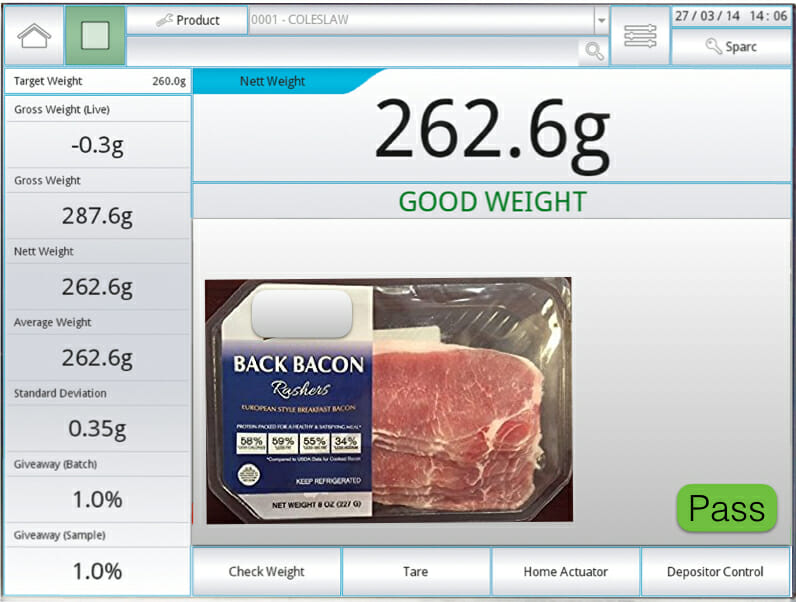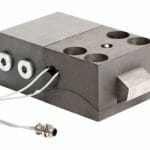The rising cost of healthy diets, an ever growing market in weight management products, hikes in prices for food staples combined with better waste management strategies is encouraging more food production facilities towards precision checkweighing and 100 percent reliable weight control. Charlie Graham, European Sales Manager at Fortress Technology and Sparc Systems examines the importance of accuracy on the scales and why weight uniformity is so critical, especially in the expanding health and wellness sector.
The global market outlook for automated checkweighing remains strong. Industry reports predict further rapid growth, with industry reports suggesting 4.6% CAGR each year between 2019 and 2027[i]. The projected expansion of this sector is likely to be propelled by a number of factors. For many FMCG manufacturers, price hikes, squeezes on profit margins, the explosion in lifestyle-led single serve and ready-to-go food packs as well as strict regulatory mandates and productivity driven investments is swinging the scale towards advanced and accurate precision checkweighing.
GET A GRIP ON GIVEAWAY
Currently, there remains plenty of untapped potential for the utilisation of automation and data collection in all weighing food production processes. Giveaway has been a long accepted practice in food factories. Many are notorious at overcompensating in the filling phases to avoid falling foul of international and domestic weight legislations.
To ensure food production facilities don’t deviate from set weights for product units, many of today’s checkweighing technologies have refined the process to deliver real time feedback data needed for quality control and interfacing with other machinery to adjust autonomously. Used efficiently, upfront checkweighing machine costs can rapidly provide a return on investment.
Sophisticated software adds full transparency to packing processes tracking each unit weight meets the set parameters as each passes over the checkweigher.
Besides reducing false rejects and product waste, the use of modern network technologies allow for automatic data transmission. With integrated data collection software, everything from trends, pack rates and live OEE data is instantly reported. Production and QA personnel can then utilise the information to monitor and fine-tune production line performance, even prior to the weight check process.
Upstream weighing systems are especially beneficial in bakery and meat processing facilities. For example, Sparc’s automated Hestia Dough Checkweigher can save bakers thousands of pounds every day. Connected to an automated upstream dough dividing line, if a piece of dough is under or overweight by as little as 0.5 grams, the Hestia Dough Checkweigher automatically rejects it. Simultaneously, the machine’s advanced fibre optic controlled software communicates back to the dough divider in real time to adjust the position of the blade for the next batch.
Similarly, if a meat manufacturer finds inconsistencies in the size of meatballs, this provides a clear indicator that processing machinery is not running accurately. Beyond highlighting this fault, precision systems, such as the Raptor checkweigher, provide a controlled feedback signal to upstream automation equipment used to portion food products. This signal specifies when to increase or decrease the fill quantity accordingly, eliminating the need for human intervention.
Deviating from a recipe also affects the value of products, notes Charlie citing ‘free from’ and ‘dietary’ ranges as classic scenarios where formulation conformity is critical. He expands: “Free-from ingredients in can cost over 150% more than conventional products. For instance, there is often 20 or more ingredients within a free-from bread recipe. Placing even greater emphasis on tightly controlling waste.”
- Data captured by Fortress and Sparc checkweighers include weight trends, pack rates and live OEE data
- Credit: iStockPhoto ArtistGNDphotography Checkweighers from Fortress and Sparc provide a controlled feedback signal to upstream automation equipment used to portion and pack food products
MAINTAINING VALUE IN MAINSTAY FOODS
Global food prices are going up. Having already encountered the pandemic-related supply chain disruptions, another surge in prices for essential commodities, ranging from grains to sugar, soybeans to corn is anticipated. It is expected to affect retailer pricing strategies for all types of products, including baked goods, ready meals and even pet food.
At the start of 2021, global food prices hit a six year high. Absorbing these additional inflation costs will in time pass down the consumer chain. Brexit and subsequent trade complications already being encountered are likely to add to the woes for British food manufacturers. The Food and Drink Federation has estimated that red tape and new border checks could add three-billion pounds in costs per year for food importers.
Shrinking pack sizes has been a common practice in recent years to counteract price rises. Manufacturers firmly lay the blame on rising raw material costs for resizing packs. Applied to chocolate bars, coffee, fruit juice, sausages, beers and even chips, the Office of National Statistics[ii] found that in just five years, 2,529 product pack sizes were made smaller.
Faced with these pressures, and in an attempt to contain domestic food prices, implementing strict waste control measures and reducing giveaway is now even more acute.
COUNTING THE CALORIES
Globally, the weight management market is projected to grow at 8.6 percent CAGR in the next five years[iii]. For this expanding market, weight checking is fundamental to authenticity, product integrity and brand protection. Charlie explains: “Absolute weighing uniformity in weight management products is non-negotiable. If your packaging states a snack bag has 100 calories, the tolerance cannot deviate by more than 0.5 grams. In this market, being bang on the weight target is critical.”
It’s why one leading British weight control company selected a special edition of Sparc’s Cerberus Combination Metal Detector and Checkweigher. Capable of checking 350 packs per minute, the Sparc processor achieves a reliable weight accuracy of ±0.25 grams. This is well within the e-mark rules, states Charlie. “Especially given that most food manufacturers work in grams not milligrams,” he points out.
By optimising the processing electro servo drive, Sparc weight sensors reset rapidly, allowing for instant and precise weight checks of individual packs in real time. Trend feedback is instantly fed upstream to filling, portioning and packing automation equipment. Signalling when to increase or decrease fill quantity. The same processing precision has been applied to the new Raptor checkweighing series
WASTE NOT …
The utilisation of automation tools and ‘smart’ inspection and checkweighing machinery helps to ensure waste remains tightly controlled and also maintains food safety and production efficiency.
Charlies expands: “Most of today’s checkweighers and combination inspection machines are ‘smart’ and connected. This allows immediate and remote access, enabling food manufacturers to view the current equipment status, monitor rejects and maintain continuous, smooth production lines. Operational data can be compared and gives production managers the ‘real time’ data to spot trends and patterns, such as when and where the most rejects are occurring. From a waste management perspective, this information is critical.”
Combination checkweighing and inspection systems bring food factories one step closer to this Smart Factory vision, whereby connected devices work alongside each other to reduce contamination, ensure food safety compliance and boost traceability and efficiency. Solutions offered by Fortress and Sparc company comprise the Theia x-ray and weighing system, the Cerberus combination metal detector and checkweigher, and now the affordable high performance Raptor checkweighing series.
All machines feature user friendly HMI touchscreen panels. This can be used to preprogramme and to calibrate numerous SKUs to avoid mistakes during product switchovers.
Explaining the importance of this Charlie says: “Integrated technology provides access to machine functions with the click of a button. This reduces the changeover time of different products, pack sizes and formats while ensuring consistent compliance with international weight and measurement standards. In some cases, up to 50% less time is required for set-up as all features are accessible from one screen.”
Summing up Charlie adds that any weighing system must drive productivity and efficiency improvements. “A checkweigher shouldn’t just be regarded as a regulatory necessity. The data that it captures can also drive untapped ROI by reducing product giveaway and food waste,” he concludes.
[i] https://coleofduty.com/news/2020/04/29/automatic-checkweigher-market-to-witness-huge-growth-by-2027/
[ii] https://www.ons.gov.uk/economy/inflationandpriceindices/articles/shrinkflationandthechangingcostofchocolate/2017-07-24
[iii] https://www.mordorintelligence.com/industry-reports/weight-management-products-market










